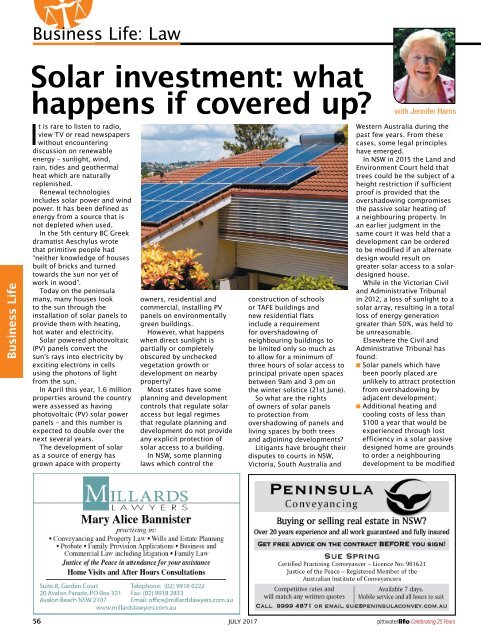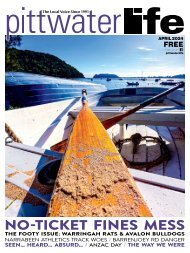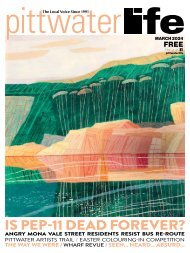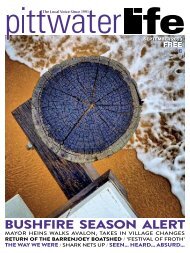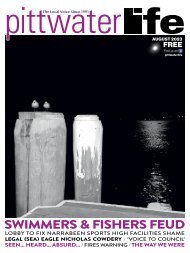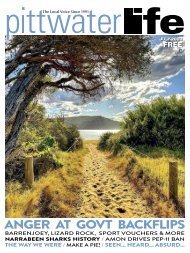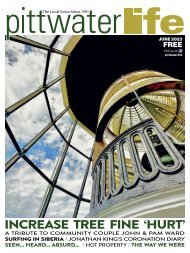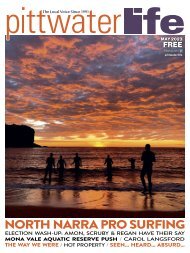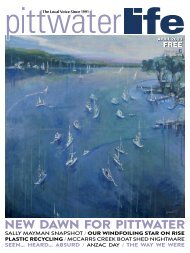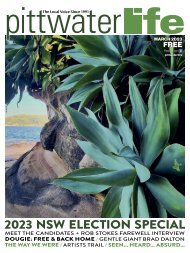Pittwater Life July 2017 Issue
Coast With The Most. Mona Vale Rd Boost. Christmas In July. B-Line Backlash. Push Is On For A Plastic Free Forever.
Coast With The Most. Mona Vale Rd Boost. Christmas In July. B-Line Backlash. Push Is On For A Plastic Free Forever.
- No tags were found...
You also want an ePaper? Increase the reach of your titles
YUMPU automatically turns print PDFs into web optimized ePapers that Google loves.
Business <strong>Life</strong>: Law<br />
Business <strong>Life</strong><br />
Solar investment: what<br />
happens if covered up?<br />
It is rare to listen to radio,<br />
view TV or read newspapers<br />
without encountering<br />
discussion on renewable<br />
energy – sunlight, wind,<br />
rain, tides and geothermal<br />
heat which are naturally<br />
replenished.<br />
Renewal technologies<br />
includes solar power and wind<br />
power. It has been defined as<br />
energy from a source that is<br />
not depleted when used.<br />
In the 5th century BC Greek<br />
dramatist Aeschylus wrote<br />
that primitive people had<br />
“neither knowledge of houses<br />
built of bricks and turned<br />
towards the sun nor yet of<br />
work in wood”.<br />
Today on the peninsula<br />
many, many houses look<br />
to the sun through the<br />
installation of solar panels to<br />
provide them with heating,<br />
hot water and electricity.<br />
Solar powered photovoltaic<br />
(PV) panels convert the<br />
sun’s rays into electricity by<br />
exciting electrons in cells<br />
using the photons of light<br />
from the sun.<br />
In April this year, 1.6 million<br />
properties around the country<br />
were assessed as having<br />
photovoltaic (PV) solar power<br />
panels – and this number is<br />
expected to double over the<br />
next several years.<br />
The development of solar<br />
as a source of energy has<br />
grown apace with property<br />
owners, residential and<br />
commercial, installing PV<br />
panels on environmentally<br />
green buildings.<br />
However, what happens<br />
when direct sunlight is<br />
partially or completely<br />
obscured by unchecked<br />
vegetation growth or<br />
development on nearby<br />
property?<br />
Most states have some<br />
planning and development<br />
controls that regulate solar<br />
access but legal regimes<br />
that regulate planning and<br />
development do not provide<br />
any explicit protection of<br />
solar access to a building.<br />
In NSW, some planning<br />
laws which control the<br />
construction of schools<br />
or TAFE buildings and<br />
new residential flats<br />
include a requirement<br />
for overshadowing of<br />
neighbouring buildings to<br />
be limited only so much as<br />
to allow for a minimum of<br />
three hours of solar access to<br />
principal private open spaces<br />
between 9am and 3 pm on<br />
the winter solstice (21st June).<br />
So what are the rights<br />
of owners of solar panels<br />
to protection from<br />
overshadowing of panels and<br />
living spaces by both trees<br />
and adjoining developments?<br />
Litigants have brought their<br />
disputes to courts in NSW,<br />
Victoria, South Australia and<br />
with Jennifer Harris<br />
Western Australia during the<br />
past few years. From these<br />
cases, some legal principles<br />
have emerged.<br />
In NSW in 2015 the Land and<br />
Environment Court held that<br />
trees could be the subject of a<br />
height restriction if sufficient<br />
proof is provided that the<br />
overshadowing compromises<br />
the passive solar heating of<br />
a neighbouring property. In<br />
an earlier judgment in the<br />
same court it was held that a<br />
development can be ordered<br />
to be modified if an alternate<br />
design would result on<br />
greater solar access to a solardesigned<br />
house.<br />
While in the Victorian Civil<br />
and Administrative Tribunal<br />
in 2012, a loss of sunlight to a<br />
solar array, resulting in a total<br />
loss of energy generation<br />
greater than 50%, was held to<br />
be unreasonable.<br />
Elsewhere the Civil and<br />
Administrative Tribunal has<br />
found:<br />
n Solar panels which have<br />
been poorly placed are<br />
unlikely to attract protection<br />
from overshadowing by<br />
adjacent development;<br />
n Additional heating and<br />
cooling costs of less than<br />
$100 a year that would be<br />
experienced through lost<br />
efficiency in a solar passive<br />
designed home are grounds<br />
to order a neighbouring<br />
development to be modified<br />
56 JULY <strong>2017</strong><br />
Celebrating 25 Years


